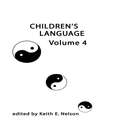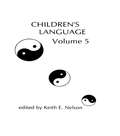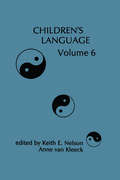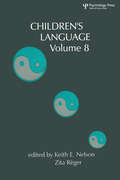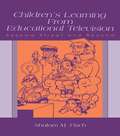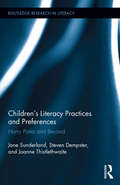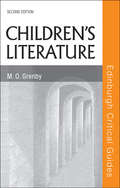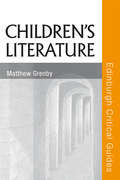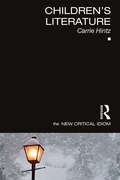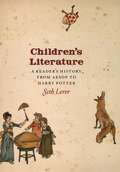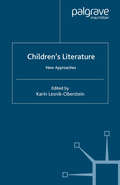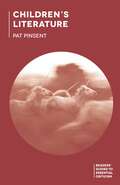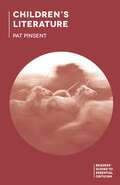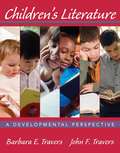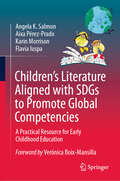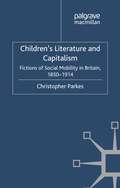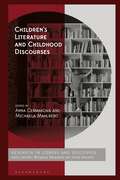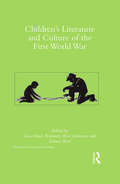- Table View
- List View
Children's Language: Volume 4 (Children's Language Series)
by K. E. NelsonFirst published in 1983. Routledge is an imprint of Taylor & Francis, an informa company.
Children's Language: Volume 5 (Children's Language Series)
by K. E. NelsonFirst published in 1985. Routledge is an imprint of Taylor & Francis, an informa company.
Children's Language: Volume 6 (Children's Language Series)
by K. Nelson Anne Van KleeckThis series, Children’s Language, reflects the conviction that extensive work on entirely new fronts along with a great deal of reinterpretation of old-front data will be necessary before any persuasive and truly orderly account of language development can be assembled. None of the chapters are simply reviews, and none of the volumes are " handbooks" or " reviews" or introductory texts. Rather the volumes try to capture the excitement and complexity of thinking and research at the growing, advancing edges of this broad field of children’s language. In line with these goals for the Children’s Language series the present volume includes coverage of a fairly wide range of topics and subtopics. The authors for each chapter will weave their own story and we leave to them the introduction of their main plots and the major and minor characters in their scientific stories. This is volume 6.
Children's Language: Volume 4 (Children's Language Series)
by Keith E. NelsonFirst published in 1983. Routledge is an imprint of Taylor & Francis, an informa company.
Children's Language: Volume 5 (Children's Language Series)
by Keith E. NelsonFirst published in 1985. Routledge is an imprint of Taylor & Francis, an informa company.
Children's Language: Volume 8 (Children's Language Series)
by Keith E. Nelson Zita R Zita RegerEach child is spoken to by genetic heritage and by the rich current set of interactional environments -- familial, local community, and broader cultural voices. Using past structures and paradigms of scholarship, scholars seek to understand what the child achieves in language and how. The tools available for this research are not static but evolve jointly through the sharing of information, and with each "brief moment in time" in efforts to look at children's languages "just as they are." Containing a wide range of contributions from developmental approaches to phonological ability, the lexicon, the grammar as well as conversation and sign language, this text details the interrelated research and theorizing discussed at a recent Budapest conference. The meeting of the International Association for the Study of Child Languages was particularly rich in the diversity of scholars present, which is highly appropriate because such diversity is integral to an informed study of children's language.
Children's Language: Volume 8 (Children's Language Series)
by Keith E. Nelson Zita RégerEach child is spoken to by genetic heritage and by the rich current set of interactional environments -- familial, local community, and broader cultural voices. Using past structures and paradigms of scholarship, scholars seek to understand what the child achieves in language and how. The tools available for this research are not static but evolve jointly through the sharing of information, and with each "brief moment in time" in efforts to look at children's languages "just as they are." Containing a wide range of contributions from developmental approaches to phonological ability, the lexicon, the grammar as well as conversation and sign language, this text details the interrelated research and theorizing discussed at a recent Budapest conference. The meeting of the International Association for the Study of Child Languages was particularly rich in the diversity of scholars present, which is highly appropriate because such diversity is integral to an informed study of children's language.
Children's Learning From Educational Television: Sesame Street and Beyond
by Shalom M. FischAt its best, educational television can provide children with enormous opportunities and can serve as a window to new experiences, enrich academic knowledge, enhance attitudes and motivation, and nurture social skills. This volume documents the impact of educational television in a variety of subject areas and proposes mechanisms to explain its effects. Drawing from a wide variety of research spanning several disciplines, author Shalom M. Fisch analyzes the literature on the impact of educational resources. He focuses on television programs designed for children rather than for adults, although adult literature is included when it is particularly relevant. In addition, much of the discussion concerns the effects of unaided viewing by children, rather than viewing in the context of adult-led follow-up activities. The role of parent-child co-viewing and issues relevant to the use of television in school or child care also receives consideration. This volume is intended to make the disparate literature on educational television's impact more accessible, by bringing it together into a centralized resource. To that end, the volume draws together empirical data on the impact of educational television programs--both academic and prosocial--on children's knowledge, skills, attitudes, and behavior. In addition to its emphasis on positive effects, this volume addresses a gap in the existing research literature regarding children's learning from exposure to educational television. Acknowledging that little theoretical work has been done to explain why or how these effects occur, Fisch takes a step toward correcting this situation by proposing theoretical models to explore aspects of the mental processing that underlies children's learning from educational television. With its unique perspective on children's educational television and comprehensive approach to studying the topic, this volume is required reading for scholars, researchers, and students working in the area of children and television. It offers crucial insights to scholars in developmental psychology, family studies, educational psychology, and related areas.
Children's Learning From Educational Television: Sesame Street and Beyond
by Shalom M. FischAt its best, educational television can provide children with enormous opportunities and can serve as a window to new experiences, enrich academic knowledge, enhance attitudes and motivation, and nurture social skills. This volume documents the impact of educational television in a variety of subject areas and proposes mechanisms to explain its effects. Drawing from a wide variety of research spanning several disciplines, author Shalom M. Fisch analyzes the literature on the impact of educational resources. He focuses on television programs designed for children rather than for adults, although adult literature is included when it is particularly relevant. In addition, much of the discussion concerns the effects of unaided viewing by children, rather than viewing in the context of adult-led follow-up activities. The role of parent-child co-viewing and issues relevant to the use of television in school or child care also receives consideration. This volume is intended to make the disparate literature on educational television's impact more accessible, by bringing it together into a centralized resource. To that end, the volume draws together empirical data on the impact of educational television programs--both academic and prosocial--on children's knowledge, skills, attitudes, and behavior. In addition to its emphasis on positive effects, this volume addresses a gap in the existing research literature regarding children's learning from exposure to educational television. Acknowledging that little theoretical work has been done to explain why or how these effects occur, Fisch takes a step toward correcting this situation by proposing theoretical models to explore aspects of the mental processing that underlies children's learning from educational television. With its unique perspective on children's educational television and comprehensive approach to studying the topic, this volume is required reading for scholars, researchers, and students working in the area of children and television. It offers crucial insights to scholars in developmental psychology, family studies, educational psychology, and related areas.
Children's Literacy Practices and Preferences: Harry Potter and Beyond (Routledge Research in Literacy)
by Jane Sunderland Steven Dempster Joanne ThistlethwaiteOver the past few decades there have been intense debates in education surrounding children’s literacy achievement and ways to promote reading, particularly that of boys. The Harry Potter book series has been received enthusiastically by very many children, boys and girls alike, but has also been constructed in popular and media discourses as a children’s, particularly a boys’, literacy saviour. Children’s Literacy Practices and Preferences: Harry Potter and Beyond provides empirical evidence of young people’s reported literacy practices and views on reading, and of how they see how the Harry Potter series as having impacted their own literacy. The volume explores and debunks some of the myths surrounding Harry Potter and literacy, and contextualizes these within children’s wider reading.
Children's Literacy Practices and Preferences: Harry Potter and Beyond (Routledge Research in Literacy #8)
by Jane Sunderland Steven Dempster Joanne ThistlethwaiteOver the past few decades there have been intense debates in education surrounding children’s literacy achievement and ways to promote reading, particularly that of boys. The Harry Potter book series has been received enthusiastically by very many children, boys and girls alike, but has also been constructed in popular and media discourses as a children’s, particularly a boys’, literacy saviour. Children’s Literacy Practices and Preferences: Harry Potter and Beyond provides empirical evidence of young people’s reported literacy practices and views on reading, and of how they see how the Harry Potter series as having impacted their own literacy. The volume explores and debunks some of the myths surrounding Harry Potter and literacy, and contextualizes these within children’s wider reading.
Children's Literature (Edinburgh Critical Guides to Literature)
by M. O. GrenbyProvides a thorough history of British and North American children’s literature from the 17th century to the present day Now fully revised and updated, this new edition includes: • a new chapter on illustrated and picture books (and includes 8 illustrations);• an expanded glossary;• an updated further reading section. Children’s Literature traces the development of the main genres of children’s books one by one, including fables, fantasy, adventure stories, moral tales, family stories, school stories, children’s poetry and illustrated and picture books. Grenby shows how these forms have evolved over 300 years and asks why most children’s books, even today, continue to fall into one or other of these generic categories. Combining detailed analysis of particular key texts and a broad survey of hundreds of books written and illustrated for children, this volume considers both long forgotten and still famous titles, as well as the new classics of the genre †“ all of them loved by children and adults alike, but also fascinating and challenging for the critic and cultural historian. Key Features • Broad historical range• Coverage of neglected as well as well-known texts• Focus on the main genres of children’s literature• Thoroughly up-to-date in terms of primary texts and critical material
Children's Literature (Edinburgh Critical Guides to Literature)
by M. O. GrenbyProvides a thorough history of British and North American children’s literature from the 17th century to the present day Now fully revised and updated, this new edition includes: • a new chapter on illustrated and picture books (and includes 8 illustrations);• an expanded glossary;• an updated further reading section. Children’s Literature traces the development of the main genres of children’s books one by one, including fables, fantasy, adventure stories, moral tales, family stories, school stories, children’s poetry and illustrated and picture books. Grenby shows how these forms have evolved over 300 years and asks why most children’s books, even today, continue to fall into one or other of these generic categories. Combining detailed analysis of particular key texts and a broad survey of hundreds of books written and illustrated for children, this volume considers both long forgotten and still famous titles, as well as the new classics of the genre †“ all of them loved by children and adults alike, but also fascinating and challenging for the critic and cultural historian. Key Features • Broad historical range• Coverage of neglected as well as well-known texts• Focus on the main genres of children’s literature• Thoroughly up-to-date in terms of primary texts and critical material
Children's Literature (The New Critical Idiom)
by Carrie HintzChildren’s Literature is an accessible introduction to this engaging field. Carrie Hintz offers a defining conceptual overview of children’s literature that presents its competing histories, its cultural contexts, and the theoretical debates it has instigated. Positioned within the wider field of adult literary, film, and television culture, this book also covers: Ideological and political movements Children’s literature in the age of globalization Postcolonial literature, ecocriticism, and animal studies Each chapter includes a case study featuring well-known authors and titles, including Charlotte’s Web, Edward Lear, and Laura Ingalls Wilder. With a comprehensive glossary and further reading, this book is invaluable reading for anyone studying Children’s Literature.
Children's Literature (The New Critical Idiom)
by Carrie HintzChildren’s Literature is an accessible introduction to this engaging field. Carrie Hintz offers a defining conceptual overview of children’s literature that presents its competing histories, its cultural contexts, and the theoretical debates it has instigated. Positioned within the wider field of adult literary, film, and television culture, this book also covers: Ideological and political movements Children’s literature in the age of globalization Postcolonial literature, ecocriticism, and animal studies Each chapter includes a case study featuring well-known authors and titles, including Charlotte’s Web, Edward Lear, and Laura Ingalls Wilder. With a comprehensive glossary and further reading, this book is invaluable reading for anyone studying Children’s Literature.
Children's Literature: A Reader's History, from Aesop to Harry Potter
by Seth LererEver since children have learned to read, there has been children’s literature. Children’s Literature charts the makings of the Western literary imagination from Aesop’s fables to Mother Goose, from Alice's Adventures in Wonderland to Peter Pan, from Where the Wild Things Are to Harry Potter. The only single-volume work to capture the rich and diverse history of children’s literature in its full panorama, this extraordinary book reveals why J. R. R. Tolkien, Dr. Seuss, Laura Ingalls Wilder, Beatrix Potter, and many others, despite their divergent styles and subject matter, have all resonated with generations of readers. Children’s Literature is an exhilarating quest across centuries, continents, and genres to discover how, and why, we first fall in love with the written word. “Lerer has accomplished something magical. Unlike the many handbooks to children’s literature that synopsize, evaluate, or otherwise guide adults in the selection of materials for children, this work presents a true critical history of the genre. . . . Scholarly, erudite, and all but exhaustive, it is also entertaining and accessible. Lerer takes his subject seriously without making it dull.”—Library Journal (starred review) “Lerer’s history reminds us of the wealth of literature written during the past 2,600 years. . . . With his vast and multidimensional knowledge of literature, he underscores the vital role it plays in forming a child’s imagination. We are made, he suggests, by the books we read.”—San Francisco Chronicle “There are dazzling chapters on John Locke and Empire, and nonsense, and Darwin, but Lerer’s most interesting chapter focuses on girls’ fiction. . . . A brilliant series of readings.”—Diane Purkiss, Times Literary Supplement
Children’s Literature: New Approaches
by K. Lesnik-ObersteinChildren's Literature: New Approaches is a guide for graduate and upper-level undergraduate students of children's literature. It is structured through critics reading individual texts to bring out wider issues that are current in the field. Includes chronology of key events and publications, a selective guide to further reading and a list of Web-based resources.
Children's Literature (Readers' Guides to Essential Criticism)
by Pat PinsentThis invaluable Guide surveys the key critical works and debates in the vibrant field of children's literature since its inception. Leading expert Pat Pinsent combines a chronological overview of developments in the genre with analysis of key theorists and theories, and subject-specific methodologies.
Children's Literature (Readers' Guides to Essential Criticism)
by Pat PinsentThis invaluable Guide surveys the key critical works and debates in the vibrant field of children's literature since its inception. Leading expert Pat Pinsent combines a chronological overview of developments in the genre with analysis of key theorists and theories, and subject-specific methodologies.
Childrens Literature: A Developmental Perspective
by Barbara E. Travers John F. TraversThis book takes a developmental approach to children's literature, offering a fresh perspective in the field. By combining children's literature with developmental psychology, future teachers and librarians will have a better understanding of the appropriate book for a child at a certain stage of their life. Each genre is covered within a chapter devoted to a certain developmental stage.
Children’s Literature Aligned with SDGs to Promote Global Competencies: A Practical Resource for Early Childhood Education
by Angela K. Salmon Aixa Pérez-Prado Karin Morrison Flavia IuspaThis book presents children’s literature as a platform for learning and helping young readers develop the knowledge, skills, and attitudes needed to thrive in an interconnected and diverse global society. It draws from various theoretical frameworks and research findings to implement critical literacy and culturally responsive teaching in the meaning-making process.The book focuses on global competencies and Sustainable Development Goals (SDGs) as intertwined concepts that work together to foster a more sustainable, inclusive, and equitable world. Developing global competencies empowers children and communities to actively participate in achieving the SDGs and addressing the pressing challenges of our time. The authors set high expectations on children as actors in transforming society. To facilitate this, the book offers an overview of child development theories as a foundation for designing developmentally appropriate practices to extend children’s books toward deep thinking and understanding. The book includes sample lessons that use cutting-edge research-based pedagogies and tools such as visible thinking routines and other approaches. Those lessons also help readers identify the Habits of Mind (HOM) children can develop by listening to and discussing stories. The HOM are attributes of good problem-finders and problem-solvers needed when confronting complex issues. The book provides resources and sample lessons that implement different thinking strategies to engage children in questioning and analyzing what they read, making them more critical. This is how children deeply understand the world and their role in creating positive change. The book aims to cultivate change-makers and global citizens through stories. It offers innovative approaches, including online learning options in accessible and engaging ways to help children think globally and act locally‘Through the power of children’s literature, this book serves a larger agenda: To build a more thoughtful world for future generations. By caring for and learning from one another through suggested activities in this book, they will share the riches and resources from across the world. As children learn about the promise of actions toward the UN Sustainable Goals, they can imagine living in an interdependent learning community where all people continually searching for ways to trust each other, learn together, and grow toward greater intelligence.’ Arthur Costa and Bena Kallick, Co-Founders and Directors of The Institute for Habits of Mind
Children's Literature and Capitalism: Fictions of Social Mobility in Britain, 1850-1914 (Critical Approaches to Children's Literature)
by C. ParkesAfter the first phase of industrialization in Britain, the child emerged as both a victim of and a threat to capitalism. This book explores the changing relationship between the child and capitalist society in the works of some of the most important writers of children's and young-adult texts in the Victorian and Edwardian periods.
Children’s Literature and Childhood Discourses: Exploring Identity through Fiction (Corpus and Discourse)
by Anna Cermakova and Michaela MahlbergChildren's literature shapes what children learn about the world. It reflects social values, norms, and stereotypes. This book offers fresh insights into some of the key issues in fiction for children, from the representation of gender to embodied cognition and the translation of children's literature.Connecting classic children's texts such as Alice in Wonderland with contemporary fiction including Murder Most Unladylike, the book innovatively brings together perspectives from corpus linguistics, stylistics, cognitive linguistics, literary and cultural studies, and human geography. It explores approaches to experiencing fiction, as well as methods for the study of literary texts. Childhood discourses are investigated through the materiality of texts, the spaces that literature takes up in libraries, the cultural history of fiction moulded through performances, as well as reading environments that shape childhood experiences, such as fashion and urban spaces.Children's Literature and Childhood Discourses emphasizes the crucial link between fictional stories and real life.
Children’s Literature and Childhood Discourses: Exploring Identity through Fiction (Corpus and Discourse)
Children's literature shapes what children learn about the world. It reflects social values, norms, and stereotypes. This book offers fresh insights into some of the key issues in fiction for children, from the representation of gender to embodied cognition and the translation of children's literature.Connecting classic children's texts such as Alice in Wonderland with contemporary fiction including Murder Most Unladylike, the book innovatively brings together perspectives from corpus linguistics, stylistics, cognitive linguistics, literary and cultural studies, and human geography. It explores approaches to experiencing fiction, as well as methods for the study of literary texts. Childhood discourses are investigated through the materiality of texts, the spaces that literature takes up in libraries, the cultural history of fiction moulded through performances, as well as reading environments that shape childhood experiences, such as fashion and urban spaces.Children's Literature and Childhood Discourses emphasizes the crucial link between fictional stories and real life.
Children's Literature and Culture of the First World War (Children's Literature and Culture)
by Emma Short Lissa Paul Rosemary R. JohnstonBecause all wars in the twenty-first century are potentially global wars, the centenary of the first global war is the occasion for reflection. This volume offers an unprecedented account of the lives, stories, letters, games, schools, institutions (such as the Boy Scouts and YMCA), and toys of children in Europe, North America, and the Global South during the First World War and surrounding years. By engaging with developments in Children’s Literature, War Studies, and Education, and mining newly available archival resources (including letters written by children), the contributors to this volume demonstrate how perceptions of childhood changed in the period. Children who had been constructed as Romantic innocents playing safely in secure gardens were transformed into socially responsible children actively committing themselves to the war effort. In order to foreground cross-cultural connections across what had been perceived as ‘enemy’ lines, perspectives on German, American, British, Australian, and Canadian children’s literature and culture are situated so that they work in conversation with each other. The multidisciplinary, multinational range of contributors to this volume make it distinctive and a particularly valuable contribution to emerging studies on the impact of war on the lives of children.
